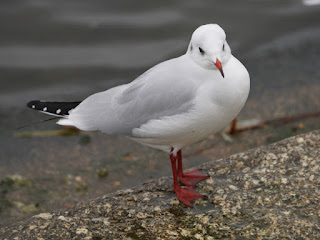It was a dismal dark day with intermittent drizzle. That suited a Blackbird at the Dell, looking for surfacing worms.
A Robin looked out from a soggy bush in the Rose Garden.
A flock of Long-Tailed Tits passed overhead.
This is one of the family of Chaffinches in the holly trees next to the bridge.
A Great Spotted Woodpecker called from the woodland at the foot of Buck Hill.
The number of Magpies hanging around the Lido restaurant is steadily increasing.
The female Peregrine was on and off the tower. I didn't see her mate.
The pigeon-eating lesser Black-Backed Gull, on the right here, and his mate were in their favourite place on the roof of the Dell restaurant.
Some of the Black-Headed Gulls have quite large white dots on their folded wingtips, like those of the larger gulls ...
... and some have hardly any. The first gull looks older, with deeper coloured feet, and I think this has something to do with it.
Great Crested Grebes don't live entirely on fish. The pair from the east end of the island were probing the mud at the edge for small invertebrates.
One of the grebes from the west end of the island intruded on what they considered their territory. Facing right in this clip, they adopted their head-down threatening attitude. The intruder did the same in the other direction, but was outnumbered and backed off.
A Moorhen had a quick wash and preen before trotting off to look for food.
The Goldeneye was still diving busily at the east end of the Serpentine.
A quick visit to the Round Pond to see if there was anything new, which there wasn't, and to check on the Black Swan.
The fig tree in the shrubbery northeast of the Albert Memorial is covered in small unripe fruit. I don't think it ever ripens. It's a Brown Turkey fig, the only kind that is self-fertile. Other figs have to be pollinated by wasps native to warmer climates.
The mild spell of a few weeks ago has misled some little white narcissi in the Rose Garden into flowering.














I had a good view of the Goldeneye today. It was drifting slowly near the bridge at the end of the Serpentine. For a change, it wasn’t diving.
ReplyDeleteWhile I was there, I saw a Herring Gull dive and catch a crayfish. It took it to dry land below the restaurant terrace. It attracted a crowd of Carrion Crows but all the birds had to scatter when a Cormorant suddenly arrived on the scene. After inspecting the crayfish for a few seconds, the Cormorant decided it wasn’t of interest and resumed fishing. This gave the gull an opportunity to start eating its catch again. Although a crow managed to grab a claw, the gull still had a hearty meal.
I've never seen a Cormorant eating a crayfish. I don't think Cormorants find them interesting.
DeleteMaybe it was hungry enough to investigate? There must not be many fishes by now.
DeleteCan confirm about wasps. They are a nuisance if you have fig trees in your backyard. We lived in constant fear for my mother, who is terribly allergic to bee and wasp poison.
Fig wasps are not like Common Wasps. and are very small. They are various members of a large superfamily, the Chalcioidea. They are mentioned in Aristotle, Historia animalium 5.32.4, who calls them ψῆνες: 'The fruit of the wild fig contains the psēn, or fig wasp. This creature is a grub at first; but in due time the husk peels off and the psēn leaves the husk behind it and flies away, and enters into the fruit of the fig tree through its orifice, and causes the fruit not to drop off; and with a view to this phenomenon, country folk are in the habit of tying wild figs on to fig trees, and of planting wild fig trees near domesticated ones.'
DeleteOur wasps were quite large common wasps that buzzed around the riping figs constantly, but I do remember seeing smaller wasps as well, which we disregarded because they weren't as aggressive. I never knew those were beneficent!
DeleteThe number of wasp species is dizzying, literally tens of thousands with many more undiscovered. Here is a giant one from Java, Megascolia procer, which has a wingspan of 11.5 cm. It parasitises an even larger insect, the Atlas beetle, Chalcosoma atlas.
Delete